Holy People
SAINT JOHN OF SHANGHAI, BELGRADE STUDENT, PROTECTOR OF JOURNALISTS
The Endless Chronicle of Miracles
He is one of the greatest Orthodox saints of the XX century. After escaping the revolutionary terror in 1917 as a Russian nobleman, he studied at the Seminary in the Serbian capital and made his living by working as a newspaper delivery boy. He entered the monastic order in 1926, in Miljko’s Monastery on the Morava river, and was ordained as bishop in 1934 in Belgrade. ”If you wish to see a living saint, go to Bitola, to father John”, Nikolaj Velimirović, the then Bishop of Ohrid, used to say about him
By: Branislav Matić
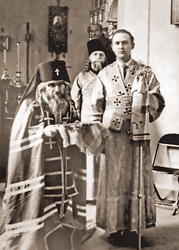 November in Belgrade, evening, in the year 1921, the third year after the Great War. It is chilly, cold is coming from the Danube and from the plain, it smells like snow. On the Terazije ridge, not far from the ”Moskva” hotel, the newspaper delivery boy takes out the just printed newspaper evening editions. He is skinny, short, his face having the color of honey or a just lit wax candle, he radiates gentleness, he is smiling, he has a strong Russian accent. His name is Mihail Borisovich Maximovitch, he is a student of the Belgrade University Seminary and this is his third year in the Serbian capital. November in Belgrade, evening, in the year 1921, the third year after the Great War. It is chilly, cold is coming from the Danube and from the plain, it smells like snow. On the Terazije ridge, not far from the ”Moskva” hotel, the newspaper delivery boy takes out the just printed newspaper evening editions. He is skinny, short, his face having the color of honey or a just lit wax candle, he radiates gentleness, he is smiling, he has a strong Russian accent. His name is Mihail Borisovich Maximovitch, he is a student of the Belgrade University Seminary and this is his third year in the Serbian capital.
Hardly any of the passersby who stop to buy newspaper could even imagine that he or she is standing before a man who will become one of the greatest Orthodox priests in the XX century.
Three years later in the Russian Church on Tašmajdan, the young newspaper delivery boy will be created a reader, and in 1926, he received the tonsure from the Metropolitan of the Russian Orthodox Church outside of Russia, Anthony Hrapovitzki, in Miljko’s Monastery on the Morava river, and was ordained as hierodeacon. He then received the monastic name John, after his holy ancestor from the XVIII century, his great granduncle, Saint John (Maximovitch) of Tobolsk.
MIHAIL
 copy.jpg) Mihail was born on June 4, 1896, in a small town of Adamovki, Kharkov Guberniya, in a famous noble family. He got his name – which means As God or The One Who Is Similar to God – at his baptizing to the honor of Archangel Michael, the archistratege of God. Mihail was born on June 4, 1896, in a small town of Adamovki, Kharkov Guberniya, in a famous noble family. He got his name – which means As God or The One Who Is Similar to God – at his baptizing to the honor of Archangel Michael, the archistratege of God.
As the son of one of the leading noblemen in the Kharkov Guberniya, he was prepared for a terrene career. In the year when World War I broke, he graduated from the Poltava Cadet Corpus, and in 1918 from the Faculty of Law at the Imperial University in Kharkov. However, even then he was almost completely dedicated to thorough studies of theology and feats of holy people. The relics of Archbishop Melentius Leontovich the Wonderworker rested in the Kharkov Ascension Church. Under the influence of this holy example and almost o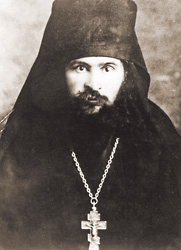 bvious spiritual forces radiating from the relics of the Wonderworker, above which he prayed every day, young Mihail began his impressive spiritual martyrdom, understandable to only a few people in this secularized era: ”For forty years he performed the same feat of night vigil, without ever laying in bed, spending night after night standing immovably, with his hands raised; even if he did fall asleep, it would be only when sleep conquers him from exhaustion, in the middle of bowing, in a corner, under the icons, on his knees.” bvious spiritual forces radiating from the relics of the Wonderworker, above which he prayed every day, young Mihail began his impressive spiritual martyrdom, understandable to only a few people in this secularized era: ”For forty years he performed the same feat of night vigil, without ever laying in bed, spending night after night standing immovably, with his hands raised; even if he did fall asleep, it would be only when sleep conquers him from exhaustion, in the middle of bowing, in a corner, under the icons, on his knees.”
The achievements of his religiousness soon became obvious to others, even at such a young age, so the competent Archbishop became interested in him, Anthony Hrapovitzki, who was one of the most prominent clergy members of his time. He attempted to bring the young man closer to him in his spiritual growing.
Soon afterwards, however, both the Metropolitan Anthony and young Mihail (with his family) came to Serbia, fleeing before the terror of the civil war and communist revolution. The Metropolitan founded the Russian Orthodox Church outside of Russia in Sremski Karlovci, while the latter enrolled at the Seminary in Belgrade.
THE PATH
 copy.jpg) After graduating from the Seminary (1925) and entering the monastic order (1926), Mihail, now already hierodeacon John, taught law at the Serbian State Gymnasium. Three years later, in 1929, he became a lecturer and educator at the Serbian Seminary of the Eparchy of Ohrid in Bitola (unofficially named the Seminary of St. John the Evangelist). That is where his miraculous way of life-martyrdom was discovered and recognized. After graduating from the Seminary (1925) and entering the monastic order (1926), Mihail, now already hierodeacon John, taught law at the Serbian State Gymnasium. Three years later, in 1929, he became a lecturer and educator at the Serbian Seminary of the Eparchy of Ohrid in Bitola (unofficially named the Seminary of St. John the Evangelist). That is where his miraculous way of life-martyrdom was discovered and recognized.
”He steadily prayed and served the Holy Liturgy every day, he was on strict lent, he ate only once a day, late in the evening, he was never angry”, write Seraphim Rose and Herman Podmoshensky in the Hagiography of St. John of Shanghai and San Francisco. ”The students were the first to discover his great feat and asceticism: they noticed he never sleeps, but, when they all fall asleep, he moves around the Seminary during the night, makes a cross over them while they sleep… immersed in Christ’s prayer. Finally, they became convinced he never sleeps in his bed… Some jokers even put bedbugs under his sheets, in order to see whether he ever goes to bed. Many years later, he admitted that he never slept in bed since his entering the monastic order. Such a battle with one’s own body is rarely seen and is extremely difficult…”
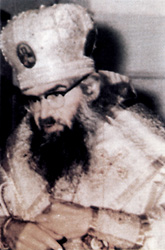 There, on the shores of the Ohrid Lake, a mystical relationship was established between John and Venerable Naum of Ohrid, student and co-martyr of St. Cyril and Method. The relics of Venerable Naum rested in a monastery dedicated to him at the Ohrid Lake. He was considered a very fast healer of mental illnesses; with his icon in his hand, John visited hospitals and healed the ill with prayers. Later he did the same in China, with the ill Chinese people. There, on the shores of the Ohrid Lake, a mystical relationship was established between John and Venerable Naum of Ohrid, student and co-martyr of St. Cyril and Method. The relics of Venerable Naum rested in a monastery dedicated to him at the Ohrid Lake. He was considered a very fast healer of mental illnesses; with his icon in his hand, John visited hospitals and healed the ill with prayers. Later he did the same in China, with the ill Chinese people.
With his dedicated behavior and wonderworking, he soon became famous. The Serbian Bishop Nikolaj Velimirović, who then managed the Ohrid eparchy, used to say: ”If you wish to see a living saint, go to Bitola, to father Jovan.”
In May 1934, the decision was made to give John the rank of bishop and he was invited to Belgrade, without yet knowing why. There is a testimony of one of his Belgrade acquaintances, who met him in the tram by accident. She asked him why he came to Belgrade, and he said that he got a notice by mistake, instead of some other hieromonk John who was supposed to be ordained as bishop. A day or two later, when she met him again, he explained that ”alas, the mistake is worse than he thought” – they decided that he was to be ordained as bishop. ”He objected, excusing himself because of his speech impediment, but they replied briefly that even Prophet Moses had the same problem”, write Rose and German Podmoshenski.
He was given the rank of bishop on May 28, 1934 in Belgrade, as the ”last and greatest one from the pleiad of bishops ordained by Metropolitan Anthony Hrapovitzky”.
MIRACLES
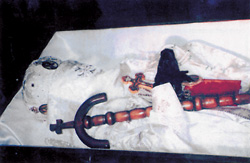 Refusing the suggestion of Archbishop Dimitri to go to the Far East, to Shanghai, where a large Russian refugee colony settled, Anthony Hrapovitzky wrote: Refusing the suggestion of Archbishop Dimitri to go to the Far East, to Shanghai, where a large Russian refugee colony settled, Anthony Hrapovitzky wrote:
”My friend, I am already so old and so weak that I cannot think of any other trip other than a trip to the cemetery. However, instead of me, as my soul, as my heart, I send you Bishop John. This man, short and weak, who resembles a child at first glance, is a miracle of martyrdom steadiness and strictness in this time of general spiritual flabbiness.”
It was a foggy morning, at the end of November 1934, when Bishop John arrived to Shanghai, to the same Bishopric where his great granduncle sent the first Orthodox mission two centuries ago, the Metropolitan of Tobolsk John Maximovitch, after which he got his monastic name. The Russian colony had about 50.000 people and it was subject of many different shocks: poverty, the (soon to happen) Japanese occupation, the government similar to the one they escaped from in Russia.
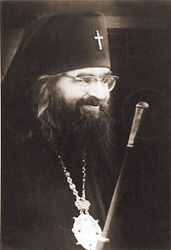 Bishop John did everything to help. The chronicle of his miracles continued in the Far East. Numerous healings beyond understanding of the mind. Taming forces of nature (such as the typhoon at the Philippine island of Tubabao). The ”unexplainable” passing through material obstacles, as if they were not there, such as entering a locked and secured hospital during a terrible storm and miraculous healing, and disappearing afterwards (the testimony about it is kept in the Shanghai state hospital archive). Reliable prophecies. He could see and hear afar, he appeared suddenly where he was most needed, although he couldn’t have known anything about it. Testimonies about it were written by N. N. Barnov, N. Nikolayev, N. S. Makawe, O. Scopichenko, L. A. Lu, Petar O. Trodin and many others. Bishop John did everything to help. The chronicle of his miracles continued in the Far East. Numerous healings beyond understanding of the mind. Taming forces of nature (such as the typhoon at the Philippine island of Tubabao). The ”unexplainable” passing through material obstacles, as if they were not there, such as entering a locked and secured hospital during a terrible storm and miraculous healing, and disappearing afterwards (the testimony about it is kept in the Shanghai state hospital archive). Reliable prophecies. He could see and hear afar, he appeared suddenly where he was most needed, although he couldn’t have known anything about it. Testimonies about it were written by N. N. Barnov, N. Nikolayev, N. S. Makawe, O. Scopichenko, L. A. Lu, Petar O. Trodin and many others.
”The Bishop lived in another world”, writes V. Reyer, who knew the Bishop well and wrote much about him. ”Was he ‘ascended to heaven’ as Apostle Paul writes, and ‘did he hear inexpressible words a human is not allowed to speak’, we don’t know. However, with his messages and deeds, he testified that the Lord has, at least a little bit, moved the curtain of His Empire for him.”
After the war and revolution in China, he alone obtained and organized the transfer of most of his congregation to America. He himself went to Western Europe. The Parisian chronicles state the words of a Catholic priest who, while addressing the skeptic youth, pointed out: ”You are looking for proof. You say there are no miracles and holy people today. Why do you need theoretic proof when, at this moment, a living saint is walking the streets of Paris, St. John the Barefoot (of Shanghai)? He is already living somewhere above our earthly level.”
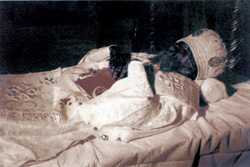 Bishop John of Hague, the head of the Dutch Orthodox Church, to whose founding St. John of Shanghai crucially contributed, wrote an eulogy in the preface of the first of all hagiographies about Bishop John, saying: ”I lost a spiritual father and I will never again find someone like him, who could call me in the middle of the night and say: ‘Now lay down and sleep. What you are praying for to God pleases him.’ Bishop! I thank you for everything. Mention us, your Dutch church, before God’s Throne.” Bishop John of Hague, the head of the Dutch Orthodox Church, to whose founding St. John of Shanghai crucially contributed, wrote an eulogy in the preface of the first of all hagiographies about Bishop John, saying: ”I lost a spiritual father and I will never again find someone like him, who could call me in the middle of the night and say: ‘Now lay down and sleep. What you are praying for to God pleases him.’ Bishop! I thank you for everything. Mention us, your Dutch church, before God’s Throne.”
He was at his Brussels cathedra, in the Memorial Church dedicated to Russian new martyrs, when he received news about the turmoil and schisms in the Russian Orthodox community in San Francisco, actually in the community of his previous Shanghai congregation. The Holy Synod sent him to return things back to order and he ”arrived to the eternally foggy city of the Far West to his last cathedra in the fall of 1962”.
DEATH
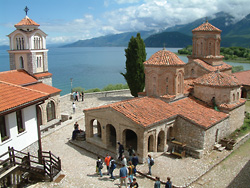 ”Following the miraculous icon of the Kursk Root Virgin in Seattle, on June 19, 1966, Bishop John served a holy liturgy in the Church of St. Nicholas, a memorial church dedicated to new martyrs, and spent another three hours in the altar. Then, after visiting his spiritual children around the church with the miraculous icon, he went to his room in the parish home. Suddenly, noise was heard from there and when the servers came running, they saw the Bishop already dying… That was when his miraculous and unearthly feat of depriving himself of sleep and rest ended. They placed him on the bed in that room, to sleep after 40 years of restraining!” (Seraphim Rose and Her ”Following the miraculous icon of the Kursk Root Virgin in Seattle, on June 19, 1966, Bishop John served a holy liturgy in the Church of St. Nicholas, a memorial church dedicated to new martyrs, and spent another three hours in the altar. Then, after visiting his spiritual children around the church with the miraculous icon, he went to his room in the parish home. Suddenly, noise was heard from there and when the servers came running, they saw the Bishop already dying… That was when his miraculous and unearthly feat of depriving himself of sleep and rest ended. They placed him on the bed in that room, to sleep after 40 years of restraining!” (Seraphim Rose and Her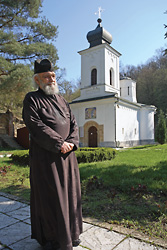 man Podmoshensky) man Podmoshensky)
The requiem began on June 24 at 6 p.m., and ended around one after midnight (because of numerous people who came to pay their last respect). The requiem was served by the clergy head, Metropolitan Filaret, together with bishops Leontije and Averkije, bishops Sava and Nektarije, 24 priests and several deacons. Six hot summer days before, his body lay on an open hearse, however ”not a single sign of rotting could be felt. His hands were soft, not stiff, although the undertaking company hasn’t manipulated his body with anything (embalming or alike)” (Orthodox Russia, no. 14, 1966).
Among other things, his definition was remembered: ”Religion is a totality of thoughts and emotions about the Supreme Being and their external expression.”
His unrotting and miraculous relics lay in the Cathedral Church in San Francisco.
***
Languages
St. John of Shanghai held holy liturgies in Russian, Serbian, Greek, Chinese, French, Dutch, English and some other languages, although most of them he never actually learned. He had an incomparable contribution in renewing the memory of Western Christian saints from the times before ”the whole Latin world was baptized into the non-transparent darkness of heretics”. He established a powerful praying community with them in all places of the Slavic diaspora.
***
Encounter
Testimonies indicate that St. John of Shanghai often appears before believers, in their dreams, beyond the illusion of senses and tumult of the crowd. ”He emanates nonmaterial light, spreads mysterious messages.”
It was a January Belgrade night in 2001. Those days, in a literary magazine and in several conversations, a man was mentioning the holy bishop. Tortured by the night, tormented by the metaphysics of pain, he fell asleep around midnight. At who knows what time, in the realm where time is not important any more, he appeared, ”in the dream”, He. He stood, gentle, in a black mantle, next to the relics of another saint very respected among Orthodox Christian Serbs.
The man tries to say something, but he has no voice. He smiles and says only two words, in Serbian: ”It will be blessed.”
The man wakes up, stares into the dense darkness over Belgrade.
The man writing this.
***
Preparation
”Several days before his death, without any reason visible to others, he took the icons of Venerable Naum and St. John the Baptist off the walls of his paraclisis in San Francisco, and placed them on the lectern in the center of the church. A few days later, everyone understood the meaning of his carrying the icons out: the Bishop died before the day celebrating the memory of Venerable Naum, and he was buried on the day of birth of St. John the Predecessor.” (Seraphim Rose)
|
